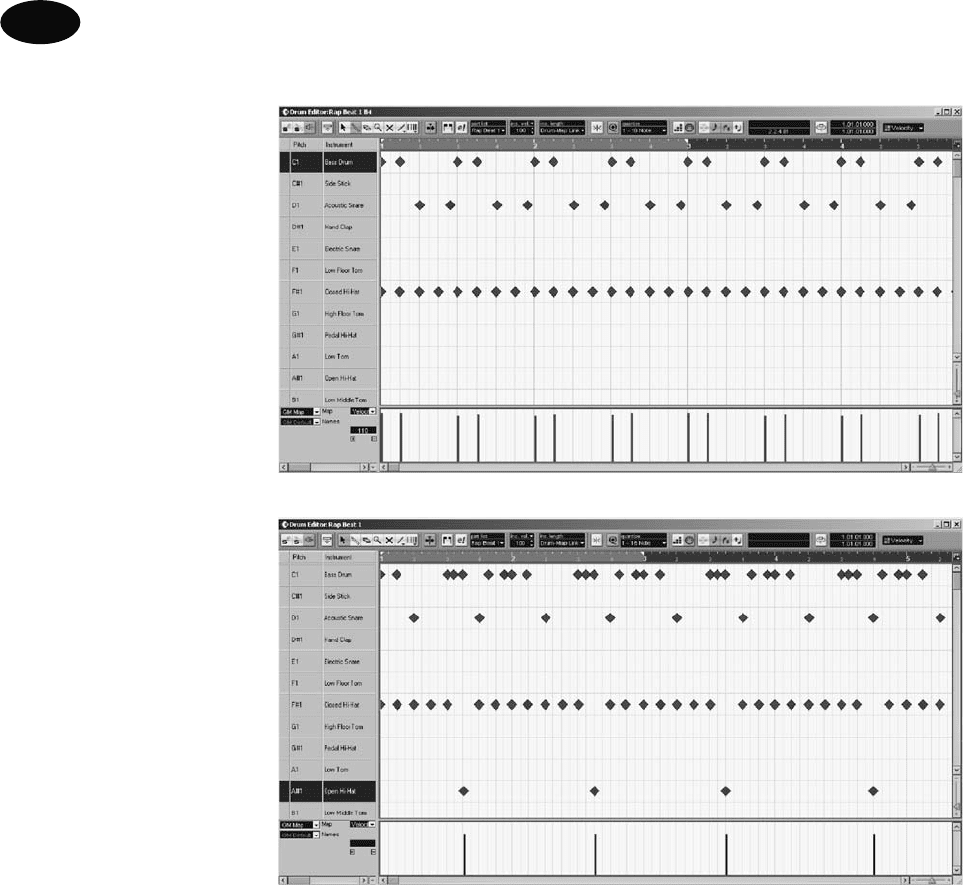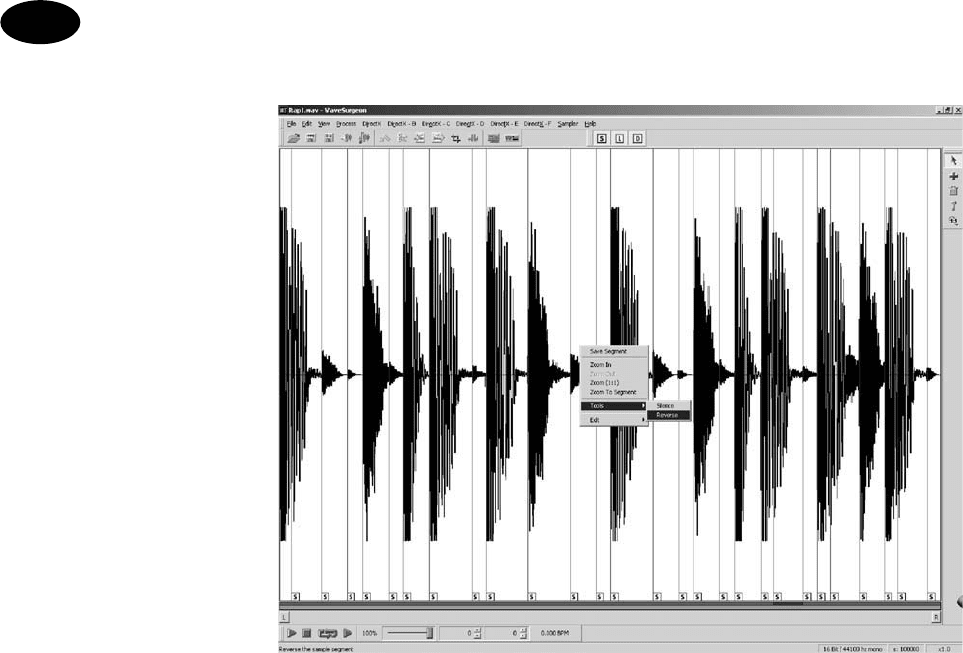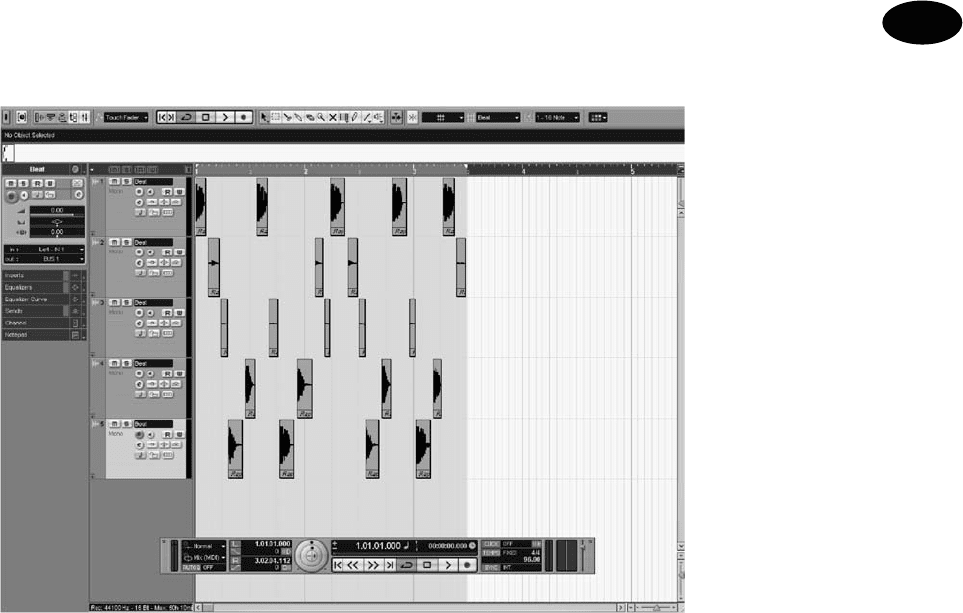Snoman R. Dance Music Manual: Tools, Toys, and Techniques
Подождите немного. Документ загружается.

This page intentionally left blank

Hip-Hop (Rap)
CHAPTER 15
295
295
295
In recent years hip-hop has become a global phenomenon, so much so that
what was once frowned upon for seemingly glorifying drugs, guns and general
delinquency has now emerged as a multi-billion pound industry. However, it
should be noted that despite the record industry’s habit of pigeon-holing abso-
lutely everything that features a rapper as hip-hop, this isn’t the case.
Hip-hop is a culture, not a form of music, and although it does encompass rap
it also embraces dancing, language and fashion. Consequently, producing rap
music has very little to do with programming some MIDI patterns and rapping
over the top. To better understand why this is, it’s vital to know a little about
the history and culture behind it all.
Hip-hop, as a culture, can be defi ned as consisting of four distinct elements:
DJ’ing, breaking, graffi ti and MC’ing (emceeing). The roots of the DJ’ing elem-
ent can be traced back to 1950s Jamaica where the ‘DJs’ began to experiment
with groove elements of records, resulting in the creation of reggae, ska and
the rocksteady beat. In 1968, this became even more experimental when King
Tubby created the fi rst ever ‘dub’ record by dropping out all the vocals from the
acetate discs he was to press (often called ‘dub’ plates).
At the same time many Jamaicans were immigrating to the United States, taking
these new ideas with them to the ghettos of New York. One particular immi-
grant, Kool Herc, began to DJ at parties throughout the ghettos and used to
chant rhymes over the top of the instrumental breaks of the records he played.
As many of these breaks were short, in 1974 he decided to play two copies of
the same record on two decks and then use a mixer to switch between them,
in effect creating a longer break beat to rhyme over. Almost simultaneously, in
another ghetto Afrika Bambaataa founded Zulu Nation, consisting of a group
Hip-Hop (Rap)
CHAPTER 15
CHAPTER 15
’ Rap is like the polio vaccine. At fi
rst no one believed in
it. Then, once they knew it worked, everyone wanted
it … ’
Grandmaster Flash

PART 2
Dance Genres
296
of DJs, break dancers, MCs and graffi ti artists, and offered an alternative to the
current street-gang culture, allowing the youth culture to express themselves in
various ways.
Inspired by these new DJ’ing tactics and culture, DJ Grandmaster Flash adopted
the style and contorted it into a continuous stream of break beats. This allowed
MCs to rhyme over the top of the beats to warm up the crowds, permitting
the DJ to concentrate on developing new techniques such as ‘beat juggling ’,
‘ scratching’, ‘cutting’ and ‘breakdown ’. Not being a DJ myself, I can’t com-
ment on what some of these techniques involve or who originally developed
them but, arguably, it was Grandmaster Flash who introduced this new com-
plex form of DJ’ing to the mass market with the release of The Adventures of
Grandmaster Flash on the Wheels of Steel in 1981.
These continual break beats also gave rise to a new dance style known as break-
ing (AKA B-Boying), which consisted of a combination of fancy, complex foot-
work, spins and balancing on hands, heads or shoulders. Many of these moves
were inspired by the relentlessly released Kung Fu movies in the 1970s but
the inspiration could be drawn from anywhere, including their rivals during
‘battles’. This is where ‘crews ’ would compete against one another to see who
was the better breaker, and in many instances a breaker had to face off against
a crew to be accepted into the clan.
This form of dancing was categorized and renamed by the media as ‘break
dancing’, but not all forms of dancing at this time were breaking. Two other
styles had developed – ‘locking’ and ‘popping’ – these involved waving arms
and sharp robotic movements which were not classed as part of the hip-hop
scene.
Alongside this new music grew another part of hip-hop culture, graffi ti. Many
credit the explosion of graffi ti to TAKI 183 and the publicity he received in the
New York Times after ‘tagging’ numerous trains in the subway.
The term ‘tag’ is used since graffi ti refers to any unwelcome defacing of property
with spray paint or markers the true hip-hop was much more artistic. A tag is
essentially the writer’s signature expressed in an artful and creative way, consisting
of three areas; the ‘tag’, the ‘throw up ’ and the ‘piece’. The tag is classed as the
simplest form of graffi ti and consists of a signature in just one colour, writ-
ten using a marker. As time moved on, spray cans were introduced and the tag
moved up a step to the throw up, which is made up of two colours, resulting in
more complex styles. The fi nal style, a piece, is the most complex form of graffi ti,
which people like Lee Quinones have made a living from selling to art galler-
ies. On the streets, however, to be referred to as a piece it must consist of at least
three colours and preferably be ‘end-to-end’ art. As most graffi ti was sprayed onto
subway trains, this latter term should be self explanatory. This type of graffi ti is
an incredibly complex form of art which, although viewed by many as destruc-
tive, takes a lot of planning, people and an artistic fl air ( although for obvious rea-
sons I cannot condone the defacing of any property).

Hip-Hop (Rap)
CHAPTER 15
297
The last element of hip-hop is MC’ing. Although the media considers rap to
be the same as MC’ing, rap is only one element of it. Indeed, MC’ing encap-
sulates everything from simply talking over the beats to rapping or using
your voice as an instrument (human beat box). As touched upon, originally
MC’ing was used to entertain the crowds by accompanying the break beats
rather than taking the focus away from them. The original form was known
as call-and-response whereby the MC would typically shout out ‘Everybody in
the house say yeah ’ to which the audience would respond with a resounding
‘ Yeah ’.
Although it would be easy to say that rap developed from this basic form of
MC’ing, to many it actually existed long before Kool Herc, Afrika Bambaataa
or Grandmaster Flash began to rhyme over the breaks. Indeed, it’s believed to
have originated in Jamaica, where stories were told in rhymes otherwise known
as ‘toasts’.
In 1974 these were developed into the very fi rst forms of rapping where the
youth would put together boastful rhymes to sit over the top of break beats in
an effort to upstage the previous rapper. The fi rst commercial pressing of rap
music was by the Fatback Band in 1979 with the title King Tim III, but it took
the Sugar Hill Gang’s Rappers Delight released later that same year to bring rap-
ping to the attention of larger record labels as a viable and acceptable (in other
words lucrative) form of music.
Over the following years, rap acts such as N.W.A, Ice T and Public Enemy
brought rap to the forefront of music and demanded a bigger audience through
their often hotly debated rhymes that were seen as glamorizing violence, pros-
titution and guns.
MUSICAL ANALYSIS
Although technology has moved on since the early pioneers began to produce
breaks from various DJ techniques, the fundamental creation of rap still relies
heavily on the sound quality generated using these techniques.
For many the turntable techniques have been replaced with more recent devel-
opments such as samplers, hardware workstations and wave editors, but the
‘ feel’ of the early techniques is still of paramount importance to producing rap.
As a result the break beats are not programmed through MIDI but are sampled
from previous obscure records and then contorted and manipulated in sample
slicing programmes such as WaveSurgeon to create new beats. This sampling is
fundamental to keeping with the original roots of hip-hop by introducing the
vintage ‘vinyl ’ feel to the music that is not possible any other way. Similarly,
many of the instrumental riffs and motifs are also sampled from early records.
It is, however, possible to programme these through MIDI provided that you
use the right instruments.
Nevertheless, the preferred option is to sample from original vinyl. In many
cases sampling will produce all the sounds used in the genre, including basses

PART 2
Dance Genres
298
and any ‘lead’ timbres. Indeed the general consensus between most profes-
sional hip-hop musicians is that if you have a good record collection, a good
record deck and a sampling workstation (such as the AKAI MPC) you can cre-
ate hip-hop.
Generally speaking, sample CDs are avoided because everyone has access
to them and no matter how CDs are contorted they can often still be recog-
nized, so obscure vinyl is the preferred choice. Of course, for legal reasons I
can’t condone stealing riffs, loops or entire segments from other records, but
many hip-hop artists agree that so long as the samples chosen are ambiguous
or manipulated enough, there is no need to clear them.
Having said that, Dr Dre (Andre Young), who’s considered by many as rap’s
current godfather, is well known to the American courts for his countless copy-
right infringements – he’s been sued over eight times in the last 3 years. In the
most publicized case, he asked for permission to use a sample from George
Lucas’ THX sonic boom and when permission was refused, used it anyway.
Consequently, he was sued for $10 million. London-based Minder Music also
successfully sued him for $1.5 million after he sampled a bass line from one of
their releases for his 2001 track ‘Let’s Get High ’.
More recently a French Jazz musician started legal proceedings to sue Dr Dre
and Eminem for $10 million because (he claims) they used his music on Slim
Shady’s ‘Kill You ’. As a result, Dr Dre has now apparently hired a musicologist to
advise him on whether he can sample music riffs without infringing copyright.
The purpose of this is not to disrespect or accuse Dr Dre or any other rap artist
of serial stealing but to simply offer food for thought before you consider that
samples may not need to be cleared at all. While the best approach is to cre-
ate a track by whatever means you feel necessary, if the track feels right, you
should always attempt to clear the samples afterwards. This is a much easier
approach than asking permission fi rst, being refused and loosing the chance to
write what potentially could have been a hit.
Generally, hip-hop can be described as using a slow, laid-back beat that can
vary from 80 BPM through to 110 BPM. As discussed most of the break beats
used are sampled from other records to create the right vibe, while any further
melodic instrumentation takes a back seat to the rapper. Consequently these
instruments play very simple melodies so as not to distract too much attention
from the rap. As a consequence, the drum rhythm is usually laid down fi rst,
followed by the rap vocals; fi nally any further melodic instruments are added
to ‘sit’ around the rap.
To accomplish this, you will need to have a good record (sample) collec-
tion, most of which have preferably only been small releases pressed in small
amounts. Not only can these be picked up for relatively small outlay at any
charity/junk shop, but you’re more likely to fi nd records that no one has ever
considered using before. No matter what the genre of music (unless it’s choir
or similar) they will all feature a break that can be sampled and manipulated

Hip-Hop (Rap)
CHAPTER 15
299
into a hip-hop beat; even unlikely records such as Don Reeve’s Non-Stop Double
Hammond Goes Around the World features some good hip-hop basses if you lis-
ten closely enough. The trick is to use your instincts and develop an ear for the
right sounds. This can only be accomplished from being actively involved in
the hip-hop scene and gaining experience at listening out for the right sounds.
THE RHYTHMS
Primarily, there are two processes used to produce hip-hop rhythms. The fi rst is
to use sampled hits from various records and then reconstruct a rhythm live by
assigning each pad of a workstation to a specifi c sample or, more commonly,
simply sample a loop or number of loops from records and edit them using
software such as WaveSurgeon. For the purpose of this chapter, we’ll look at
both methods, starting with sampling single hits.
Sampling individual hits is only recommended if you have access to a hard-
ware drum sampler with pads, as creating the hip-hop vibe requires a ‘live ’ feel.
Indeed, very few professional rappers will rely on a software sequencer to pro-
duce hip-hop but instead use a hardware sampler and sequencers since the tim-
ing must be incredibly accurate. Although most of these samplers will default at
16-bit 44.1 kHz, for hip-hop it’s recommended to sample the hits at 22 kHz and
12-bit. This reduces the range of the samples, giving them a grittier feel which
is often essential. Once sampled, each of the hits is assigned its own pad in the
sampler, allowing you to tap out a live rhythm, piece by piece.
Hip-hop rhythms are generally kept quite simple and often consist of nothing
more than a kick drum, snare, and closed and open hi-hats along with an occa-
sional cymbal crash employed every 4 or so bars to mark the end of a musical
segment. The time signature can also play a fundamental role; hip-hop may use
either 4/4 or 3/4 depending on the amount of swing you need the drums to
exhibit. What is important, however, is that very few, or in some cases none of
the hits are quantized to the grid. The idea is to create the feel of a real drummer
and very few drummers play exactly to the beat. Additionally, the pattern very
rarely follows the typical kick/snare/kick/snare confi guration used in most genres
of dance and often relies more on rhythmic interplay between a few kicks fol-
lowed by a snare which is followed by another few kicks and a snare. On top of
this, a closed hi-hat pattern often follows a standard 16th pattern ticking away
in the background to keep some rhythmic drive and syncopation to the loop.
In the following example, the closed hi-hats are providing some offbeat syn-
copation while both the kick and the snare are occurring ahead of time to
increase the feel of a laid-back groove ( Figure 15.1 ).
In the next example, more emphasis has been placed on rhythmic interaction
between the snares and the drum kick. The closed hi-hat pattern has also been
reduced and does not occur on the same beat as the open hi-hat to prevent any
frequency clashes between the two. More importantly, though, note how very
few of the elements actually occur on the beat ( Figure 15.2 ).

PART 2
Dance Genres
300
FIGURE 15.1
A typical laid-back
hip-hop rhythm
FIGURE 15.2
A more complex
rhythm
The real key to producing a hip-hop rhythm in this manner is to experiment
with the interplay between the kicks and snares and ensure that they are off-
set from the beat to introduce the laid-back nature of the music. After this has
been accomplished, the hi-hats are added to introduce some syncopation to
the fi nal groove. Also, as the above examples reveal, hip-hop tends to be based
around the constant repetition of 2 bars of music, allowing for a binary phrase
to be applied in the bass or chorded lead if used/required. Following this it’s
sensible to create a drum rhythm that continues over 2 bars before repeating
again at the end.
Typically, in most music of this genre there are no variations in the rhythm, as
this tends to distract from the most important element of the track, but velocity

Hip-Hop (Rap)
CHAPTER 15
301
plays a large role in the creation of the rhythm to keep the realism. The most
usual method to implement is the strong –weak–medium–weak syncopation on
the kick drums. The snares, too, are often subjected to different velocities, with
the fi rst and fi nal snares using the highest values and those in between using a
mixture of different values.
As touched upon, the common approach to producing this ‘live ’ effect is to
play the sampler workstation pads live and record the subsequent MIDI data
for editing later. This is one of the reasons why many hip-hop artists will use
the AKAI MPC sampler workstations – the pads can respond to 16 different
velocity values depending on how hard they are hit. There is no need to cre-
ate the entire loop in one run. Typically the drum’s kick is recorded fi rst, then
played back from the unit while the snare rhythms are tapped in over the top.
This is then followed with the open hi-hat patterns, followed by the closed
patterns and any additional auxiliary percussion. This approach is preferred
to ‘stamping’ in notes in a MIDI sequencer, since the timing becomes far too
accurate and the MIDI delay between sequencer and sound source can result in
the groove being lost.
Of course, even with the rhythm programmed in the sampler, it’s highly proba-
ble that they will need some slight quantizing so that any further elements will
lock to it, but any strict quantizing should be avoided altogether. The principle
is to create a rhythm that has a loose feel but at the same time not so loose
that the instruments do not lock to its rhythm. Once this has the right fl ow,
the MPC’s various synthesis parameters are used to manipulate each drum
timbre to produce a rhythm that fl ows along. This can involve anything from
pitch-shifting individual snares to create more complex rhythms to tweaking
the decay parameters to either lengthen or reduce them to create sharper, more
distinct patterns or create slow-fl owing patterns. Ultimately, experimentation is
the true nature here and close listening to the most popular current hip-hop
tracks will let you know whether you’re on the right track.
The second process to produce a hip-hop rhythm is to sample entire breaks from
records and then manipulate these so that they no longer sound like the original
and are more suited towards rap. This is often the preferred approach by many
artists as the principle is much closer to the music produced by its original fore-
fathers. This must be applied cautiously, however, since many record companies
do not look lightly on sampling their artists’ material. Regardless, this doesn’t
seem to have discouraged many hip-hop artists; most will sample a loop and
then manipulate it with various synthesis parameters to make it totally unrecog-
nizable. This is accomplished through sampling the loop and importing it into
an audio sequencer such as Ableton Live, Logic or Cubase.
Many programmers do not settle for simply moving parts around. In most
cases they will adapt the sounds further by using the mixing desk as a sound
design tool before sampling the results. Typical application of this is to EQ the
snares heavily to produce hi-hats or bright kicks. Similarly, transient design-
ers such as SPL’s Transient Designer, the software plug-in included in the Waves

PART 2
Dance Genres
302
Transform bundle, can be used to edit the attack and sustain of audio enve-
lopes. For instance by setting the attack parameters on these quite long you can
remove the initial attack of the hit to produce a different timbre, while shorten-
ing the sustain parameter can make snares appear much tighter, snappier and
controlled ( Figure 15.3 ).
As an alternative to simply using and splicing one loop, it is often worth sam-
pling three or four loops. Then they can each be lined up in an audio sequencer
and time-stretched so that each is playing at the correct tempo. Taking this lat-
ter approach, all the loops can be played simultaneously and elements from
each loop can be cut up and removed to produce a rhythm composed of con-
stituent parts from each loop ( Figure 15.4 ).
This can help you create complex polyrhythms, but it’s important to note that
for this to work each drum loop should be quite simple, since the more com-
plex each is the more the combined rhythm will sound muddy and indistinct.
This can make it particularly diffi cult to create a good rhythm through slicing
and removing samples. Also, it isn’t absolutely necessary to ensure that all the
sampled loops occur at the same time. In many instances by moving one of
the loops forwards by a few ticks you can create a more laid-back feel, since the
snares will occur off the quantize values. Indeed, this technique is applied by
many hip-hop artists during sampling. Rather than sampling the beginning of
FIGURE 15.3
Cutting up and
rearranging a rhythm

Hip-Hop (Rap)
CHAPTER 15
303
the drum track (i.e. from the fi rst kick) they often sample the rhythm halfway
through and then loop this to create the complete drum loop.
With this technique, the kicks are obviously positioned in a different place
than in the original record, meaning that the sample may start on a snare or
even a hi-hat. To overcome this, it’s common practice to remove the original
kicks using sequencing software and then reprogramme a new kick loop to sit
over the original sample. Typically, this new kick is derived from the Roland
TR808 drum synthesizer, which is sampled at 12-bit 22 kHz to produce a gritty
timbre. If you don’t have access to this synth, then any synthesizer can produce
the requisite sounds using a 60 Hz sine wave positively modulated with a pitch
envelope set to a fast attack and short decay. Although you can synthesize an
additional transient to sit over this by using a square wave, generally, the hip-
hop kick remains quite ‘boomy ’ without a prominent attack so, this isn’t par-
ticularly necessary but it is worth experimenting with.
Once the basic tone is present, lengthening the pitch decay will produce a timbre
with a heavier boom, but this can only be lengthened so far before it begins
to produce a sound that whoops. If this is the case, then changing the pitch
decays envelope from linear to exponential (convex) will help to make it boom
more. While these methods will produce a deep 808 kick, it may be worth
using a self-oscillating fi lter and a noise gate in its place. This particular tech-
nique has already been discussed in sound design, but to recap quickly begin
FIGURE 15.4
Lining up a series of
loops and removing
elements to create a
basic rhythm
